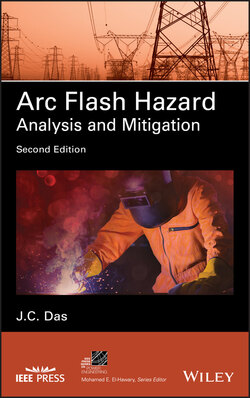Читать книгу Arc Flash Hazard Analysis and Mitigation - J. C. Das - Страница 26
1.8 ARC FLASH HAZARD ANALYSIS
ОглавлениеAs early as December 1970, the Occupational Safety and Health Act required that each employer shall furnish to his employees, employment and place of employment that are free from recognized hazards that are causing or likely to cause death or serious physical harm to his employees. It was not till late 1991 that OSHA added words acknowledging arc flash as an electrical hazard. NFPA published the first edition of NFPA 70E in 1979.
Effective from January 1, 2009, the National Electric Safety Code (NESC) [32] requires that all power generating utilities perform arc flash assessments. The employer shall ensure that assessment is performed to determine potential exposure to an electric arc for employees who work on or near energized parts or equipment. If the assessment determines a potential employee exposure greater than 1.2 cal/cm2 exists, the employer shall require employees to wear clothing or a clothing system that has an effective arc rating not less than the anticipated level of arc energy.
Currently, there are four major guides for arc flash calculations:
1 NFPA 70E, revised in 2018 [17]
2 IEEE 1584 Guide, 2018, which will undergo revisions [9]
3 IEEE 1584a, 2004, amendment 1 [33]
4 IEEE P1584b/D2 Draft 2, unapproved [34].
NFPA 70E 2012, in annex D, table D.1, provides limitations of various calculation methods. This is reproduced in Table 1.4. The standard does not express any preference for which method should be used. Reference [33] recognizes use of knowledge and experience of those who have performed studies as a guide in applying the standard. IEEE 1584 Guide also contains a theoretically derived model applicable for any voltage.
It is recognized that to construct an accurate mathematical model of the arcing phenomena is rather impractical. This is because of the spasmodic nature of the fault caused by arc elongation blowout effects, physical flexing of cables and bus bars under short circuits, possible arc reignition, turbulent flow of plasma, and high temperature gradients (the temperature at the core being of the order of 25,000 K, while at the arc boundary, of the order of 300–2000 K).
IEEE 1584 Guide equations are empirical equations based upon laboratory test results, though the standard includes some of Lee’s equations also.
TABLE 1.4. Limitations of ARC Flash Hazard Calculation Methods
Source: NFPA 70E-2018. © 2018 National Fire Protection Association.
| Source | Limitations/Parameters |
| Ralph Lee [11] | Calculates arc flash boundary for arc in open air; conservative over 600 V and becomes more conservative as voltage rises |
| Doughty and Neal [14] | Calculated incident energy for three-phase arc on systems rated 600 V and below, applies to short-circuit currents between 16 and 50 kA |
| Ralph Lee [11] | Calculated incident energy for three-phase arc in open air on systems rated above 600 V, becomes more conservative as voltage rises |
| IEEE Standard 1584 [9] | Calculates incident energy and arc flash boundary for 208 V to 15 kV, three-phase 50–60 Hz; 700–106,000 A short-circuit currents and 13–152 mm conductor gaps.a |
| ANSI/IEEE C2, tables 410-1, 410-2 [32] | Calculates incident energy for open-air phase-to-ground arcs 1 kV to 500 kV for live line work. |
| Doan | Arc flash calculations for exposure to DC systems. Calculates incident energy for DC systems up to 1000 V DC. |
a Equations for higher voltages are included.
If the equipment is maintained under deenergized condition, there is no arc flash hazard. NFPA 70E [17] states that energized electrical conductors and circuit parts that operate at less than 50 V to ground should not be required to be de-energized. Again, it is qualified that the capacity of the source and any overcurrent protection between the source and the worker should be determined and there should be no increased exposure to electrical burns or explosion due to electrical arcs. The IEEE 1584 Guide states that equipment below 240 V need not be analyzed for arc flash unless it involves at least one 125 kVA or larger low impedance transformer in its immediate power supply. The “low impedance” is not defined. Sometimes, the arc flash hazard can be high even in systems of 240 V. When incident energy exceeds 40 cal/cm2, the equipment should only be maintained in the de-energized condition. There is no PPE (personal protective equipment) outfits specified for incident energy release >40 cal/cm2; see Section 1.9 for definitions and discussions of PPE.
That an arc flash analysis shall not be required where all the following conditions exist has been deleted in NFPA 70E 2012:
The circuit is rated 240 V or less.
The circuit is supplied by one transformer.
The transformer supplying the circuit is rated less than 125 kVA.
This qualification has now been removed in 1584, 2018 edition.
The user is referred to IEEE Guide 1584 for three-phase systems rated less than 240 V.
